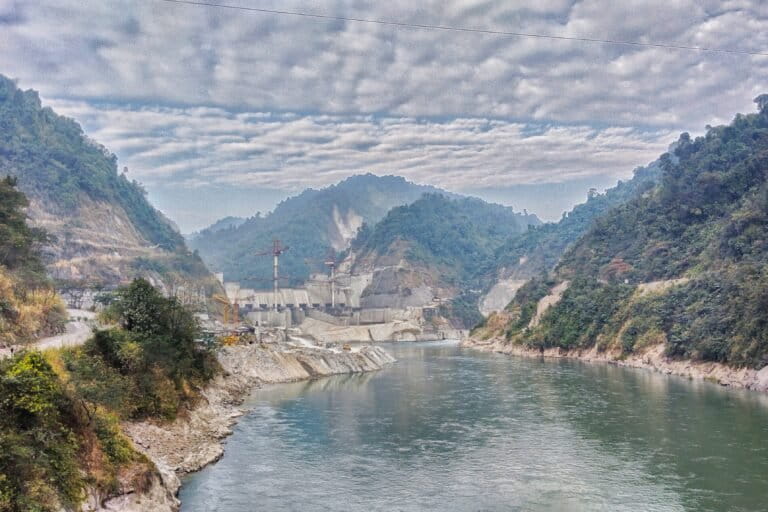- In Surguja district’s Lundra forest range, a network of women in a cluster of villages is patrolling the forests to save trees from felling.
- Around eight to ten groups of about 70 women from seven villages in Chhattisgarh stay connected via mobile phones and alert each other about any possible attempt to chop trees down.
- The thinning tree cover has led to a loss of forest produce like fruits, vegetables or medicinal herbs, which villagers use.
- The women’s vigil has begun to pay off as forest density near villages has been improving, even as villagers bemoan lack of support from the forest department.
A group of women sits huddled in a circle for a meeting, in a village in Lundra forest range of Chhattisgarh’s Surguja district, about 100 kilometres away from state capital Raipur. At the sarpanch Dhaneshwari Bai’s house, a resident of the village, has called an urgent meeting after she spotted a few tree stumps in the forest, indicative of recent felling. The women decide to start round-the-clock patrolling of the forest, in light of the recent violation. The women of Karahi, a village with about 100 households, patrol in groups to protect the forest from further damage.
Earlier, Karahi had a moderate climate throughout the year, but recently, extreme weather events such as droughts have started impacting the residents, mentioned Mangho Bai, a resident of the village. “We are not literate, but we have come to know that the weather is affected owing to massive deforestation,” she said.
The villagers depend on the forest for firewood, medicinal herbs and vegetables and fruits. However, some people would cut a huge number of trees, Mangho said, adding that it prompted her and her sisters in arms to start patrolling.
Reminiscing the greenery that prevailed over the village when she had first come after getting married 15 years ago, Basanti Bai, another resident of the village, said the green cover now stands depleted and bald patches have emerged.
Karahi became famous three years ago when its women started the initiative to tackle damage to the forest. Several other women from nearby villages have also joined this vigilante force. From patrolling inside the forest to raiding houses of the accused, it’s all in a day’s work for these women.
Twenty-five years ago, a few women here had come together to form a bachat samooh (a financial savings collective) to encourage financial saving. Three years ago, they also introduced saving trees under their agenda.

Declining greenery
The forest cover of Surguja district was 45.55% of its geographical area in 2009 and 45.02% in 2019. The exploitation of the forests has affected forest produce and many fruits, such as mahua and amla (gooseberry), are only found rarely now, villagers say.
“Earlier we used to collect shatawar, kali musli, galfuli and many other natural medicines that helped cure many diseases. But these days, it is difficult to find such plants in the forest,” stated Shiv Sagar Ram, a resident and local medicinal plants expert, attributing the decline to deforestation.
“Kaanda [a root vegetable] used to be our primary vegetable during summers and could have been found by digging one or two feet, but now the particular species [of the vegetable] has vanished from the forest,” he added.
Situated in the northern part of Chhattisgarh, Surguja district is spread over plateaus, highlands, plains and hills with a large portion of the total area covered by forests. The majority of the local inhabitants comprise tribal people and migrants from other marginalised groups. The residents use resources from the forest to fulfil their daily requirements such as fuelwood, medicines, timber wood for constructing houses and agricultural equipment.
Forests in the Eastern Ghats are also witnessing the adverse impact of human activities on the number of tree species.
Additionally, a study has showed that forest cover in the Eastern Ghats was low around village settlements, indicating the correlation between human presence and declining greenery.
Read more: Climate change, land-use change may enhance plant species loss in the Eastern Ghats
Modus operandi
Women of these villages in Surguja district are determined to save their surroundings from a similar predicament. In their meetings, a list of threats to the forest is prepared. In one such meeting, it was found out that a century-old tradition of constructing mandaps (small tents for worship) during weddings and festivals was the major cause of deforestation. Another threat was from the local woodcutters, who sell wood in the market after cutting down big trees. Villagers also collect wood from the forest but as per the guidelines of the forest department, they are not allowed to cut green trees. However, women found that some villagers were violating that regulation as well.
Sumitra Purte, an active member of bachat samooh, mentioned that the first step was creating awareness regarding the importance of forests. They explained the importance of small trees in the forest ecology, and urged the villagers to use old wood for events, she added.

Whenever a family in the village organises a pooja (prayer ceremony), a villager alerts the group and the women approach the family to discourage them from cutting trees. However, it has not been easy for a women-only group to convince people. They had to raid houses and confiscate wood.
Bhulsi Bai, sarpanch of a village, told Mongabay-India that they increased the pressure on the residents, while also raising awareness. Her manifesto underlined the importance of the forest and she has been elected for a second consecutive time.
“We are still struggling to curb the activities of professional woodcutters. Being a woman, there is always a fear of security while going to the forest, so male members of our village also started helping us in this cause. They help us with torches at night while we go for patrolling,” Bhulsi added.
Shiv Sagar, who is member of a volunteer organisation Van Raksha Samiti (forest protection committee), coordinates with the forest department to protect the forest. He mentioned that the forest department would provide them with the necessary equipment like torches for night patrolling. However, he says the forest department is not supportive of their initiative.
He said, “Sometimes we seize wood but the officials take two to three days to respond. Sometimes we take wood by ourselves to the wood depot of the forest department, but we didn’t receive much support.”
Forest density improving in Surguja
The regular patrolling by the women acts as a deterrent for those wanting to cut trees in the forest region. Their endeavour has started to show results as small trees are not being felled anymore and the forest’s tree density is beginning to improve. The front face of the village is green once again and one can see the dense forest near the road while entering the village.
Though the total area of forest in Surguja has reduced, the area of very dense forest has more than doubled in the last 10 years – from 320 square km in 2009 to 706.72 square km in 2019. This shows that though the dense parts are improving, open forest area and moderate forest near the village are facing depletion.
When Mongabay-India tried to get a comment from forest officials on this issue, the conservator of Surguja district, A.B. Minz stated that he was not aware of the initiative by the women and forest ranger Priyanka Pandey was not available to comment on this issue.
Recognising the efforts of women groups, Nirmala Kirkita, a local activist and resident of a nearby village, stated that earlier, people would use certain tricks, such as cutting the bark of the tree to kill it, but increased awareness among villagers have stopped it.
The group of about 70 women organised in 8-10 groups across seven villages have stayed connected through mobile phones.
“Mobile phones are really very helpful in our work,” said Fircho Bai.
Almost every household of the village owns a mobile phone and it is easy to communicate and gather for meetings, she added.

Banner image: A group of women who patrol their forests to save trees. Photo by Manish Chandra Mishra.
The author is a Bhopal-based freelance writer and a member of 101Reporters.com, a pan-India network of grassroots reporters.














